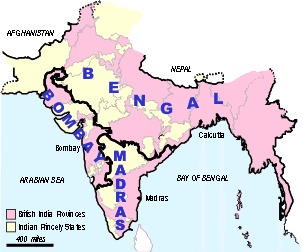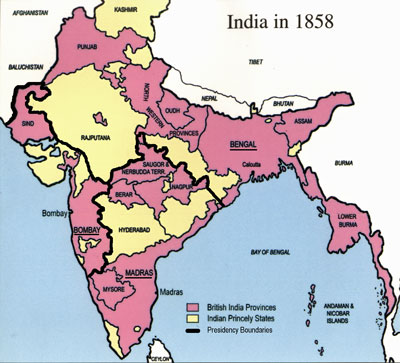Difference between revisions of "Presidencies"
| Line 1: | Line 1: | ||
| + | [[Image:presidencies.gif|frame|right|1930's Presidency Map]] | ||
During the 17th Century the East India Company’s major trading centres were based upon ‘factories’ at | During the 17th Century the East India Company’s major trading centres were based upon ‘factories’ at | ||
* [[Fort William]] at [[Calcutta]] in [[Bengal]] (established in 1690) | * [[Fort William]] at [[Calcutta]] in [[Bengal]] (established in 1690) | ||
| Line 14: | Line 15: | ||
* Agra (1834-1843) | * Agra (1834-1843) | ||
| − | The boundaries between the presidencies varied from time to time but their positions at the time of the [[Indian Mutiny]] are shown | + | The boundaries between the presidencies varied from time to time but their positions at the time of the [[Indian Mutiny]] are shown on the 1930's Presidency map on the right of this page. |
| − | |||
| − | |||
Following the establishment of the Raj in 1858, major changes took place; | Following the establishment of the Raj in 1858, major changes took place; | ||
| Line 25: | Line 24: | ||
By the 1930's, when India was approaching Independence, the map of India had become as shown on the map to the right. | By the 1930's, when India was approaching Independence, the map of India had become as shown on the map to the right. | ||
| − | + | [[Image:presidencymap1858.jpg|frame|right|1858 Presidency Map]] | |
Knowing which Presidency a town or city was in, is important when consulting many of the [[India Office Records]] held at the [[British Library]]. | Knowing which Presidency a town or city was in, is important when consulting many of the [[India Office Records]] held at the [[British Library]]. | ||
Also note that administrative boundaries changed from time to time and it is important to check 'border' districts in the adjoining area. The above map is adapted from Plate 21 of the (1931) revised atlas of the [[Imperial Gazetteer]] of India. Such small scale maps cannot show every enclave of territory, and this map is not to be taken as an authority for boundaries. For more detail see the provincial maps in the Imperial Gazetteer atlas, and large scale published Survey of India topographical maps. | Also note that administrative boundaries changed from time to time and it is important to check 'border' districts in the adjoining area. The above map is adapted from Plate 21 of the (1931) revised atlas of the [[Imperial Gazetteer]] of India. Such small scale maps cannot show every enclave of territory, and this map is not to be taken as an authority for boundaries. For more detail see the provincial maps in the Imperial Gazetteer atlas, and large scale published Survey of India topographical maps. | ||
| + | |||
| + | [[Category:Locations]] | ||
Revision as of 18:26, 20 November 2007
During the 17th Century the East India Company’s major trading centres were based upon ‘factories’ at
- Fort William at Calcutta in Bengal (established in 1690)
- Fort St George on the Coromandel Coast (established 1640)
- Bombay on the northern Malabar Coast (given by King Charles II in 1668)
These three locations developed to become the centres of Military and Political control as the Company’s influence grew during the 18th and 19th centuries and they became known as the three Presidencies of:
- Bengal – which included Burma and the Straits Settlements (Penang, Malacca and Singapore)
- Madras
- Bombay – which included Aden
Additionally, two other presidencies were established and subsequently disbanded:
- Bencoolen - at Fort Marlborough in Sumatra (1759-1803)
- Agra (1834-1843)
The boundaries between the presidencies varied from time to time but their positions at the time of the Indian Mutiny are shown on the 1930's Presidency map on the right of this page.
Following the establishment of the Raj in 1858, major changes took place;
- Berar, Saugor & Nerbudda and Orissa passed from Madras to Bengal in 1861
- Baluchistan was acquired by Bengal in
By the 1930's, when India was approaching Independence, the map of India had become as shown on the map to the right.
Knowing which Presidency a town or city was in, is important when consulting many of the India Office Records held at the British Library.
Also note that administrative boundaries changed from time to time and it is important to check 'border' districts in the adjoining area. The above map is adapted from Plate 21 of the (1931) revised atlas of the Imperial Gazetteer of India. Such small scale maps cannot show every enclave of territory, and this map is not to be taken as an authority for boundaries. For more detail see the provincial maps in the Imperial Gazetteer atlas, and large scale published Survey of India topographical maps.

